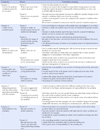Abstract
Purpose
The purpose of this study was to describe nurses' experiences of accidents in patient safety.
Methods
Data were collected from October 8, 2011 to January 31, 2012 through in-depth interviews with seven nurses who had worked on wards or in the ICU in a university hospital. Data were analyzed by applying Colaizzi's phenomenological methodology.
Results
The following six categories were extracted: Fear of the patient's condition caused by the accident, Conflict in the accident report, Blame on others and circumstances, Feeling guilty and sorry as the patient's condition is improving, Being disappointed with the unfavorable atmosphere in dealing with the accident, After the accident, being sensitive in performing nursing duties and being faithful to the principles.
Conclusion
The results indicate that the organizational culture in the hospital related to accidents in patient safety is still closed and punitive, and such an atmosphere causes nurses to feel seriously hurt, but through this experience nurses are likely to mature as nursing professionals. Programs on prevention of accidents in patient safety and a system to guard against these accidents should be established. Also the organizational safety culture should be improved.
Figures and Tables
References
1. Colaizzi PF. Psychological research as the phenomenologist views it. In : Valle RS, King M, editors. Existential phenomenological alternatives for psychology. NY: Oxford University Press;1978.
2. Elder NC, Brungs SM, Nagy M, Kudel I, Render ML. Nurses' perceptions of error communication and reporting in the intensive care unit. J Patient Saf. 2008; 4:162–168. http://dx.doi.org/10.1097/PTS.0b013e3181839b48.
3. Elder NC, Graham D, Brandt E, Hickner J. Barriers and motivators for making error reports from family medicine offices: A report from the American Academy of Family Physicians National Research Network (AAFP NRN). J Am Board Fam Med. 2007; 20:115–123. http://dx.doi.org/10.3122/jabfm.2007.02.060081.
4. Fontan JE, Maneglier V, Nguyen VX, Loirat C, Brion F. Medication errors in hospital: Computerized unit dose drug dispensing system versus ward stock distribution system. Pharm World Sci. 2003; 25:112–117. http://dx.doi.org/10.1023/A:1024053514359.
5. Jeong J, Seo YJ, Nam EW. Factors affecting patient safety management activities at nursing divisions of two university hospitals. Korean J Hosp Manage. 2006; 11:91–109.
6. The Joint Commission Resources. Joint Commission Standard page: National patient safety goals. 2013. Retrieved October 10. from http://www.jointcommission.org/standards_information/npsgs.aspx.
7. Kim CC, Suh MJ. An analysis of fall incidence rate and its related factors of fall in inpatients. J Korean Soc Qual Assur Health Care. 2002; 9:210–228.
8. Kim EK, Kang M, Kim HJ. Experience and perception on patient safety culture of employees in hospitals. J Korean Acad Nurs Adm. 2007; 13:321–334.
9. Kim HY, Kim HS. Effects of perceived patient safety culture on safety nursing activities in the general hospital nurse's. J Korean Acad Nurs Adm. 2011; 17:413–422.
10. Kim JE, Kang MS, An KE, Sung YH. A survey of nurses' perception of patient safety related to hospital culture and reports of medical errors. Clin Nurs Res. 2007; 13:169–179.
11. Kim KK, Song MS, Lee KS, Hur HK. Study on factors affecting nurses' experience of non-reporting incidents. J Korean Acad Nurs Adm. 2006; 12:454–463.
12. Kim KJ. Development of website-based patient safety culture promotion program. J Korean Clin Nurs Res. 2013; 19:152–167.
13. Kim MS. Perception and influencing factors for patient safety among emergency room nurses. Ulsan, Korea: Industrial Technology;2012. Unpublished master's thesis.
14. Kim YL. Perceptions of patient safety culture of hospital nurses. Jeonju, Korea: Chonbuk National University;2009. Unpublished master's thesis.
15. Knaack P. Phenomenological Research. West J Nurs Res. 1984; 6:107–114. http://dx.doi.org/10.1177/019394598400600108.
16. Lee EK, Jung CH, Jeon HJ. Experiences of nurses in medication errors. Qual Res. 2010; 11:94–105.
17. Lincoln YS, Guba EG. Naturalistic inquiry. London: Sage;1985.
18. Mahajan RP. Critical incident reporting and learning. Br J Anaesth. 2010; 105(1):69–75.
19. Mayo AM, Duncan D. Nurse perceptions of medical error: What we need to know for patient safety. J Nurs Care Qual. 2004; 19:209–217.
20. Noh YN. Analysis of perception patient safety culture among hospital workforce. Seoul, Korea: Yonsei University;2008. Unpublished master's thesis.
21. Nieva VF, Sorra J. Safety culture assessment: A tool for improving patients safety in healthcare organizations. Qual Saf Health Care. 2003; 12:Suppl 2. ii17–ii23. http://dx.doi.org/10.1136/qhc.12.suppl_2.ii17.
22. Oh CH, Yoon HS. Perception and experience of medication errors in nurses with less than one year job experience. J Korean Acad Fundam Nurs. 2007; 14:6–17.
23. Park BK. Professional self-concept of hospital nurses and nursing mission study. Seoul, Korea: Kyung Hee University;2001. Unpublished master's thesis.
24. Quality Improvement Nurse Society. Guidelines for practitioners to learn QI activities. Seoul: INNOMAX;2010.
25. Santell JP, Hicks RW, McMeekin J, Cousins DD. Medication errors: Experience of the United States Pharmacopeia (USP) MEDMARX Reporting System. J Clin Pharmacol. 2003; 43:760–767. http://dx.doi.org/10.1177/0091270003254831.
26. Schelbred A, Nord R. Nurses' experiences of drug administrationerrors. J Adv Nurs. 2007; 60:317–324. http://dx.doi.org/10.1111/j.1365-2648.2007.04437.x.
27. Webster CS, Anderson DJ. A practical guide to the implementation of an effective incident reporting scheme to reduce medication error on the hospital ward. Int J Nurs Pract. 2002; 8:176–183. http://dx.doi.org/10.1046/j.1440-172X.2002.00368.x.
28. Wu AW. Medical error: The second victim. BMJ. 2000; 320:726–727. http://dx.doi.org/10.1136/bmj.320.7237.726.
29. Yoon NY, Lee JE. Influences of nurses' safety culture and patient safety in general hospital. Korean Rev Crisis Emerg Manage. 2012; 4(1):60–80.




 PDF
PDF ePub
ePub Citation
Citation Print
Print




 XML Download
XML Download